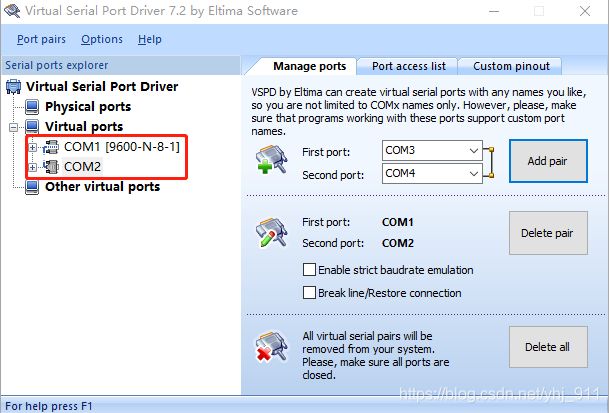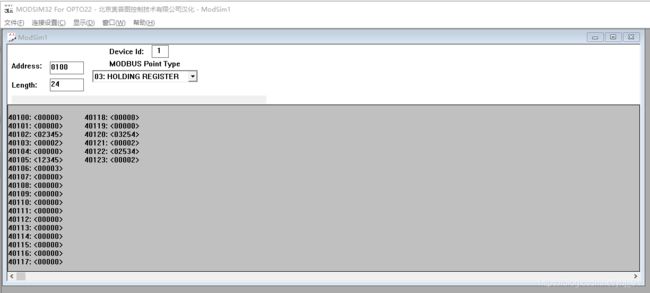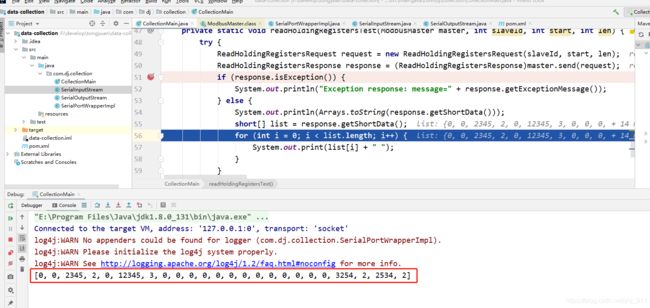使用java的modbus4j的Rtu方式获取监测数据
最近要从modbus总线上获取数据,还要用java开发,找了半天,感觉modbus4j在github上评价比较高,尝试了一下,果然很好用,比之前的方法方便很多。在使用过程中也踩了不少坑,记录下来,分享给大家,100%好用,上传了全部代码,东西一点都不缺少。
1、配置串口环境
使用virtual serial port driver模拟串口com1、com2

2、配置下位机环境
使用modsim模拟下位设备
deviceid:设备ID
modbus point type:寄存器模式
address:寄存器起始位置
length:寄存器存储长度

选择COM1口

3、上位机接口使用java的modbus4j实现
modbus4j的SerialPortWrapper接口没有实现类,推荐使用Freedomotic中的三个类实现:
SerialPortWrapperImpl.java
SerialInputStream.java
SerialOutputStream.java
为了大家使用方便,这里直接上源代码
SerialPortWrapperImpl.java
package com.dj.collection;
/**
*
* Copyright (c) 2009-2020 Freedomotic Team http://www.freedomotic-iot.com
*
* This file is part of Freedomotic
*
* This Program is free software; you can redistribute it and/or modify it under
* the terms of the GNU General Public License as published by the Free Software
* Foundation; either version 2, or (at your option) any later version.
*
* This Program is distributed in the hope that it will be useful, but WITHOUT
* ANY WARRANTY; without even the implied warranty of MERCHANTABILITY or FITNESS
* FOR A PARTICULAR PURPOSE. See the GNU General Public License for more
* details.
*
* You should have received a copy of the GNU General Public License along with
* Freedomotic; see the file COPYING. If not, see
* SerialInputStream.java
126行、127行必须进行如下修改
// System.arraycopy(readBuf, 0, buf, offset, length);
System.arraycopy(readBuf, 0, buf, offset, readBuf.length);
package com.dj.collection;
/*
* To change this template, choose Tools | Templates
* and open the template in the editor.
*/
import jssc.SerialPort;
import java.io.IOException;
import java.io.InputStream;
/**
* Class that wraps a {@link SerialPort} to provide {@link InputStream}
* functionality. This stream also provides support for performing blocking
* reads with timeouts.
*
* It is instantiated by passing the constructor a {@link SerialPort} instance.
* Do not create multiple streams for the same serial port unless you implement
* your own synchronization.
*
* @author Charles Hache
*
* Attribution: https://github.com/therealchalz/java-simple-serial-connector
*
*/
public class SerialInputStream extends InputStream {
private SerialPort serialPort;
private int defaultTimeout = 0;
/**
* Instantiates a SerialInputStream for the given {@link SerialPort} Do not
* create multiple streams for the same serial port unless you implement
* your own synchronization.
*
* @param sp The serial port to stream.
*/
public SerialInputStream(SerialPort sp) {
serialPort = sp;
}
/**
* Set the default timeout (ms) of this SerialInputStream. This affects
* subsequent calls to {@link #read()}, {@link #blockingRead(int[])}, and
* {@link #blockingRead(int[], int, int)} The default timeout can be 'unset'
* by setting it to 0.
*
* @param time The timeout in milliseconds.
*/
public void setTimeout(int time) {
defaultTimeout = time;
}
/**
* Reads the next byte from the port. If the timeout of this stream has been
* set, then this method blocks until data is available or until the timeout
* has been hit. If the timeout is not set or has been set to 0, then this
* method blocks indefinitely.
*/
@Override
public int read() throws IOException {
return read(defaultTimeout);
}
/**
* The same contract as {@link #read()}, except overrides this stream's
* default timeout with the given timeout in milliseconds.
*
* @param timeout The timeout in milliseconds.
* @return The read byte.
* @throws IOException On serial port error or timeout
*/
public int read(int timeout) throws IOException {
byte[] buf = new byte[1];
try {
if (timeout > 0) {
buf = serialPort.readBytes(1, timeout);
} else {
buf = serialPort.readBytes(1);
}
return buf[0];
} catch (Exception e) {
throw new IOException(e);
}
}
/**
* Non-blocking read of up to buf.length bytes from the stream. This call
* behaves as read(buf, 0, buf.length) would.
*
* @param buf The buffer to fill.
* @return The number of bytes read, which can be 0.
* @throws IOException on error.
*/
@Override
public int read(byte[] buf) throws IOException {
return read(buf, 0, buf.length);
}
/**
* Non-blocking read of up to length bytes from the stream. This method
* returns what is immediately available in the input buffer.
*
* @param buf The buffer to fill.
* @param offset The offset into the buffer to start copying data.
* @param length The maximum number of bytes to read.
* @return The actual number of bytes read, which can be 0.
* @throws IOException on error.
*/
@Override
public int read(byte[] buf, int offset, int length) throws IOException {
if (buf.length < offset + length) {
length = buf.length - offset;
}
int available = this.available();
if (available > length) {
available = length;
}
try {
byte[] readBuf = serialPort.readBytes(available);
// System.arraycopy(readBuf, 0, buf, offset, length);
System.arraycopy(readBuf, 0, buf, offset, readBuf.length);
return readBuf.length;
} catch (Exception e) {
throw new IOException(e);
}
}
/**
* Blocks until buf.length bytes are read, an error occurs, or the default
* timeout is hit (if specified). This behaves as blockingRead(buf, 0,
* buf.length) would.
*
* @param buf The buffer to fill with data.
* @return The number of bytes read.
* @throws IOException On error or timeout.
*/
public int blockingRead(byte[] buf) throws IOException {
return blockingRead(buf, 0, buf.length, defaultTimeout);
}
/**
* The same contract as {@link #blockingRead(byte[])} except overrides this
* stream's default timeout with the given one.
*
* @param buf The buffer to fill.
* @param timeout The timeout in milliseconds.
* @return The number of bytes read.
* @throws IOException On error or timeout.
*/
public int blockingRead(byte[] buf, int timeout) throws IOException {
return blockingRead(buf, 0, buf.length, timeout);
}
/**
* Blocks until length bytes are read, an error occurs, or the default
* timeout is hit (if specified). Saves the data into the given buffer at
* the specified offset. If the stream's timeout is not set, behaves as
* {@link #read(byte[], int, int)} would.
*
* @param buf The buffer to fill.
* @param offset The offset in buffer to save the data.
* @param length The number of bytes to read.
* @return the number of bytes read.
* @throws IOException on error or timeout.
*/
public int blockingRead(byte[] buf, int offset, int length) throws IOException {
return blockingRead(buf, offset, length, defaultTimeout);
}
/**
* The same contract as {@link #blockingRead(byte[], int, int)} except
* overrides this stream's default timeout with the given one.
*
* @param buf The buffer to fill.
* @param offset Offset in the buffer to start saving data.
* @param length The number of bytes to read.
* @param timeout The timeout in milliseconds.
* @return The number of bytes read.
* @throws IOException On error or timeout.
*/
public int blockingRead(byte[] buf, int offset, int length, int timeout) throws IOException {
if (buf.length < offset + length) {
throw new IOException("Not enough buffer space for serial data");
}
if (timeout < 1) {
return read(buf, offset, length);
}
try {
byte[] readBuf = serialPort.readBytes(length, timeout);
System.arraycopy(readBuf, 0, buf, offset, length);
return readBuf.length;
} catch (Exception e) {
throw new IOException(e);
}
}
@Override
public int available() throws IOException {
int ret;
try {
ret = serialPort.getInputBufferBytesCount();
if (ret >= 0) {
return ret;
}
throw new IOException("Error checking available bytes from the serial port.");
} catch (Exception e) {
throw new IOException("Error checking available bytes from the serial port.");
}
}
}
SerialOutputStream.java
package com.dj.collection;
/**
*
* Copyright (c) 2009-2020 Freedomotic Team http://www.freedomotic-iot.com
*
* This file is part of Freedomotic
*
* This Program is free software; you can redistribute it and/or modify it under
* the terms of the GNU General Public License as published by the Free Software
* Foundation; either version 2, or (at your option) any later version.
*
* This Program is distributed in the hope that it will be useful, but WITHOUT
* ANY WARRANTY; without even the implied warranty of MERCHANTABILITY or FITNESS
* FOR A PARTICULAR PURPOSE. See the GNU General Public License for more
* details.
*
* You should have received a copy of the GNU General Public License along with
* Freedomotic; see the file COPYING. If not, see
*
* It is instantiated by passing the constructor a {@link SerialPort} instance.
* Do not create multiple streams for the same serial port unless you implement
* your own synchronization.
*
* @author Charles Hache
*
* Attribution: https://github.com/therealchalz/java-simple-serial-connector
*
*/
public class SerialOutputStream extends OutputStream {
SerialPort serialPort;
/**
* Instantiates a SerialOutputStream for the given {@link SerialPort} Do not
* create multiple streams for the same serial port unless you implement
* your own synchronization.
*
* @param sp The serial port to stream.
*/
public SerialOutputStream(SerialPort sp) {
serialPort = sp;
}
@Override
public void write(int b) throws IOException {
try {
serialPort.writeInt(b);
} catch (SerialPortException e) {
throw new IOException(e);
}
}
@Override
public void write(byte[] b) throws IOException {
write(b, 0, b.length);
}
@Override
public void write(byte[] b, int off, int len) throws IOException {
byte[] buffer = new byte[len];
System.arraycopy(b, off, buffer, 0, len);
try {
serialPort.writeBytes(buffer);
} catch (SerialPortException e) {
throw new IOException(e);
}
}
}
4、pom.xml文件
<?xml version="1.0" encoding="UTF-8"?>
<project xmlns="http://maven.apache.org/POM/4.0.0"
xmlns:xsi="http://www.w3.org/2001/XMLSchema-instance"
xsi:schemaLocation="http://maven.apache.org/POM/4.0.0 http://maven.apache.org/xsd/maven-4.0.0.xsd">
<modelVersion>4.0.0</modelVersion>
<groupId>org.example</groupId>
<artifactId>data-collection</artifactId>
<version>1.0-SNAPSHOT</version>
<build>
<plugins>
<plugin>
<groupId>org.apache.maven.plugins</groupId>
<artifactId>maven-compiler-plugin</artifactId>
<configuration>
<source>6</source>
<target>6</target>
</configuration>
</plugin>
</plugins>
</build>
<!-- 若想引用modbus4j需要引入下列repository id:ias-snapshots id:ias-releases 两个 -->
<repositories>
<repository>
<releases>
<enabled>false</enabled>
</releases>
<snapshots>
<enabled>true</enabled>
</snapshots>
<id>ias-snapshots</id>
<name>Infinite Automation Snapshot Repository</name>
<url>https://maven.mangoautomation.net/repository/ias-snapshot/</url>
</repository>
<repository>
<releases>
<enabled>true</enabled>
</releases>
<snapshots>
<enabled>false</enabled>
</snapshots>
<id>ias-releases</id>
<name>Infinite Automation Release Repository</name>
<url>https://maven.mangoautomation.net/repository/ias-release/</url>
</repository>
</repositories>
<dependencies>
<!-- 串口通信 begin-->
<!-- https://mvnrepository.com/artifact/org.rxtx/rxtx -->
<dependency>
<groupId>org.rxtx</groupId>
<artifactId>rxtx</artifactId>
<version>2.1.7</version>
</dependency>
<!-- https://mvnrepository.com/artifact/org.scream3r/jssc -->
<dependency>
<groupId>org.scream3r</groupId>
<artifactId>jssc</artifactId>
<version>2.8.0</version>
</dependency>
<dependency>
<groupId>com.infiniteautomation</groupId>
<artifactId>modbus4j</artifactId>
<version>3.0.3</version>
</dependency>
<!-- 串口通信 end-->
<dependency>
<groupId>org.apache.commons</groupId>
<artifactId>commons-lang3</artifactId>
<version>3.7</version>
</dependency>
<dependency>
<groupId>org.slf4j</groupId>
<artifactId>slf4j-log4j12</artifactId>
<version>1.7.25</version>
</dependency>
</dependencies>
</project>
5、主调用程序
package com.dj.collection;
import java.util.Arrays;
import com.serotonin.modbus4j.ModbusFactory;
import com.serotonin.modbus4j.ModbusMaster;
import com.serotonin.modbus4j.exception.ModbusInitException;
import com.serotonin.modbus4j.exception.ModbusTransportException;
import com.serotonin.modbus4j.msg.ReadHoldingRegistersRequest;
import com.serotonin.modbus4j.msg.ReadHoldingRegistersResponse;
import com.serotonin.modbus4j.serial.SerialPortWrapper;
/**
* 通过串口解析MODBUS协议
* @author yaohj
*/
public class CollectionMain {
// 设定MODBUS网络上从站地址
private final static int SLAVE_ADDRESS = 1;
//串行波特率
private final static int BAUD_RATE = 9600;
public static void main(String[] args) {
SerialPortWrapper serialParameters = new
SerialPortWrapperImpl("COM2", BAUD_RATE, 8, 1, 0, 0, 0);
/* 创建ModbusFactory工厂实例 */
ModbusFactory modbusFactory = new ModbusFactory();
/* 创建ModbusMaster实例 */
ModbusMaster master = modbusFactory.createRtuMaster(serialParameters);
/* 初始化 */
try {
master.init();
readHoldingRegistersTest(master, SLAVE_ADDRESS, 99, 24);
} catch (ModbusInitException e) {
e.printStackTrace();
} finally {
master.destroy();
}
}
/**
* 读保持寄存器上的内容
* @param master 主站
* @param slaveId 从站地址
* @param start 起始地址的偏移量
* @param len 待读寄存器的个数
*/
private static void readHoldingRegistersTest(ModbusMaster master, int slaveId, int start, int len) {
try {
ReadHoldingRegistersRequest request = new ReadHoldingRegistersRequest(slaveId, start, len);
ReadHoldingRegistersResponse response = (ReadHoldingRegistersResponse)master.send(request);
if (response.isException()) {
System.out.println("Exception response: message=" + response.getExceptionMessage());
} else {
System.out.println(Arrays.toString(response.getShortData()));
short[] list = response.getShortData();
for (int i = 0; i < list.length; i++) {
System.out.print(list[i] + " ");
}
}
} catch (ModbusTransportException e) {
e.printStackTrace();
}
}
}
